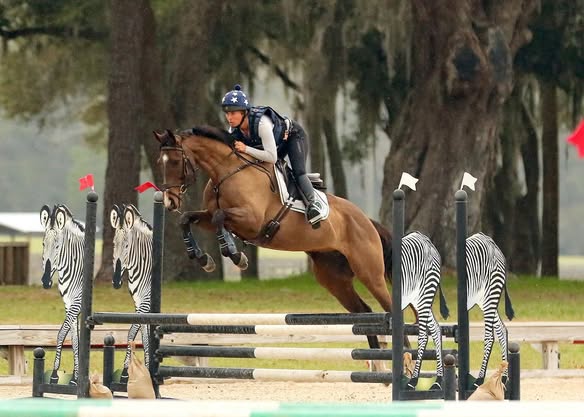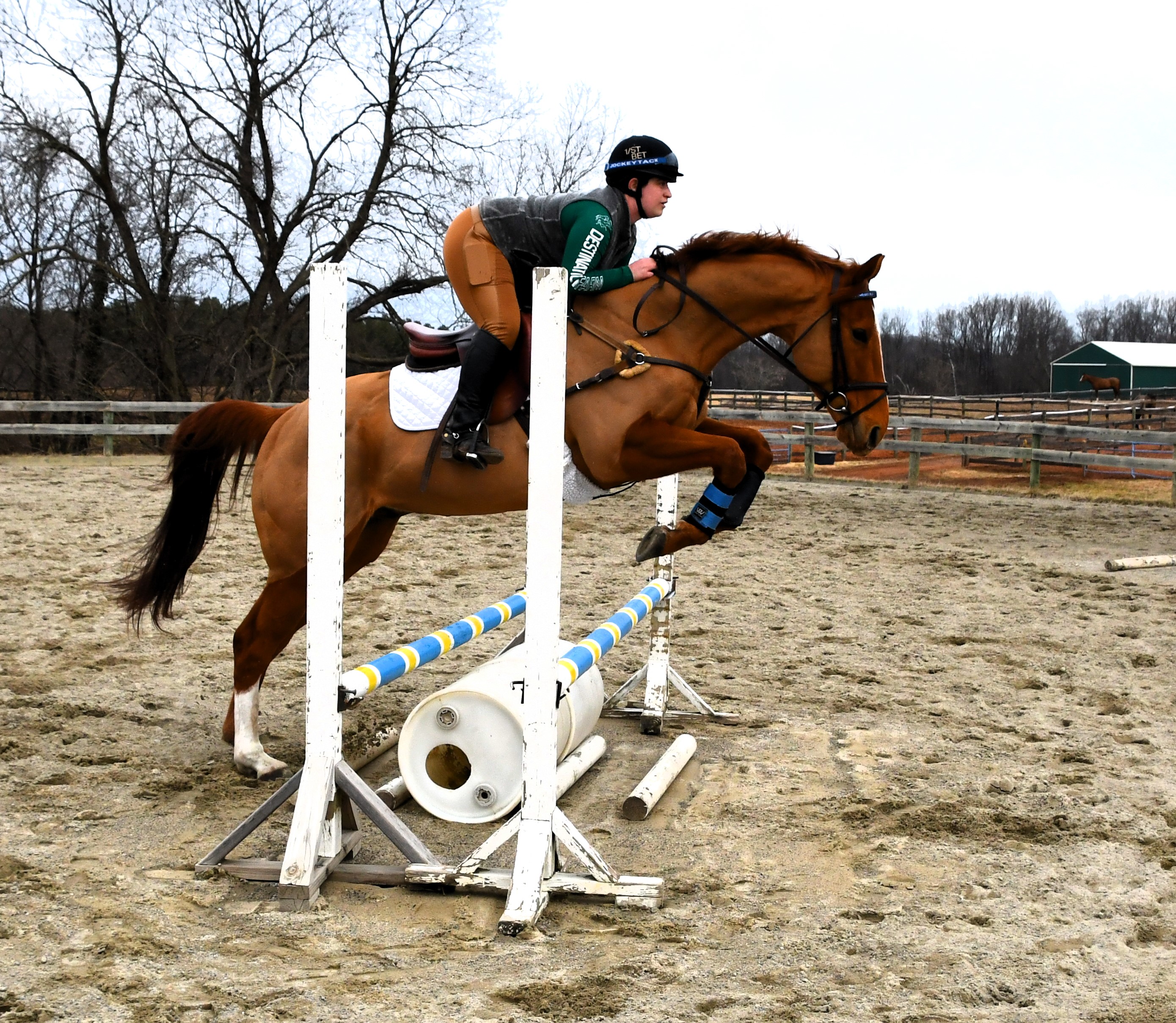On June 1, 2021, the USEA instituted a new policy: at training level and above, a competitor who has 20 or more jump faults in the show jumping phase of an event must compulsorily retire. If you scrolled down the results of an event during the past year, every now and then you may have seen a ‘CR’ next to the final result of a competitor. Those letters describe that situation. The full rule and an explanation of its intent, as published in an April 2021 announcement, is as follows:
EV150 Penalties
During a round, penalties are incurred for:
20 show jump penalties – Compulsory Retirement
COMPULSORY RETIREMENT
A competitor incurs 20 or more jump penalties in show jumping at the Training level or higher. Enforced at the end of the round unless the competitor retires or is eliminated.
Rule Change Intent: This rule is being presented to reduce risk in the sport of eventing. The reasoning has been that in reviewing the incidence of poor riding at competitions, the performance records of those riders that have died in schooling situations, data from EquiRatings, and other indicators, the USEA Cross-Country Safety Subcommittee views it as important to highlight that poor show jumping performance should result in retirement. They believe this should be equally applied regardless of whether show jumping or cross-country occur first in the schedule of the competition. British Eventing instituted this rule for similar reasons and it would be an additional measure to lessen risk in the sport. Compulsory Retirement (CR) designation was chosen to distinguish the penalty from fall of horse (Mandatory Retirement, MR) for tracking purposes.
Thanks to the USEA providing it, we have access to data about how often, and at which level, these CRs have been occurring. We also have access to data about how often horses and riders have more than 20 jumping penalties in FEI eventing. At FEI events, there is no CR rule. A horse can have five rails, six rails, or eight rails and still be permitted to run cross country. Thus, it provides an interesting comparison to the USEA system. The data is summarized below:
| US Eventing | ||
| Comp Results with Final Score of CR or | ||
| FEI Divisions with SJ Jump Pen 20+ | ||
| June 1, 2021 to June 1, 2022 | ||
| All Results | CR or SJ=20+ | ||
| Level | Count | Count | % |
| CCI5-L | 103 | 7 | 6.80% |
| CCI4-L | 110 | 2 | 1.82% |
| CCI3-L | 195 | 5 | 2.56% |
| CCI2-L | 298 | 10 | 3.36% |
| CCI4-S | 433 | 1.39% | |
| CCI3-S | 581 | 17 | 2.93% |
| CCI2-S | 550 | 13 | 2.36% |
| CCI1-L | 69 | 5 | 7.25% |
| CCI1-S | 57 | 2 | 3.51% |
| A | 348 | 10 | 2.87% |
| AI | 113 | 1 | 0.88% |
| I | 1426 | 39 | 2.73% |
| IP | 105 | 4 | 3.81% |
| P3D | 2 | 0 | 0.00% |
| P | 4207 | 58 | 1.38% |
| M3D | 5 | 0 | 0.00% |
| M | 1583 | 16 | 1.01% |
| MT | 105 | 3 | 2.86% |
| PT | 231 | 14 | 6.06% |
| T3D | 91 | 0 | 0.00% |
| T | 7728 | 92 | 1.19% |
There are four main takeaways from the data:
- The incidence rate of CRs is very small, at any USEA level. Varying between 0.00% and 6.06%, this means that in a typical division of, for example, 16 horses and riders, there is likely to be on average at most one compulsory retirement. In other words this rule is not affecting many horses and riders.
- The USEA incidence rate of CRs is highest at the IP and PT levels.
- The USEA incidence rate of CRs varies by level, and there is a slight trend in the traditional levels (i.e. non-hybrid divisions, so excluding the IP/PT/MT divisions) upward as the levels of difficulty increase (i.e. bigger jumps at the higher levels do tend to correlate with more CRs).
- The incidence rate of would-be CRs at FEI levels is higher (averaging 3.55%) than the actual CRs (averaging 1.90%) at national levels. The highest would-be CRs at FEI are at the CCI1-L and CCI5-L levels. (Would-be CRs are those FEI rounds with more than 20 jumping penalties.)
The purpose of compulsory retirements (‘CRs’) is to reduce risk in the sport. While there are so many factors that can contribute to dangerous falls, the USEA determined that high incidence of refusals and rails in the show jumping phase correlate with cross country falls. Accordingly, they instituted a blanket retirement rule for horses and riders with more than 20 jumping penalties at a show.
This is a ‘per se’ rule, meaning that it is a generalized rule applied without consideration for specific circumstances. The rule is simple and objective. There is no judge who reviews your equitation or your horse’s jumping form or your ability to see a distance. There is just the blanket per se rule: 20 penalties or more, and you have a CR. There are advantages and disadvantages to a per se rule.
On the one hand, it is transparent and objective. There is no sense that subjectivity is creeping into the enforcement of the rule. Furthermore, there is no responsibility on TDs or judges to pull aside a competitor who has had five fences down in show jumping and explain to them why they shouldn’t run cross country. The rule does it for them.
On the other hand, it may be over- or under-inclusive. In the former instance, it may capture too many horses and riders who have an uncharacteristic round and tap a few rails but would still be safe out on cross country. I know a couple of horses that are careless in show jumping but have perfect cross-country records. These horses would suffer from the rule, and for them it seems to be unfair.
But a blanket rule can be under-inclusive — that is, it may also capture too few horses and riders in the sense that perhaps five rails (20 penalties) is too high of a threshold. Four rails is a lot of rails as well—and there is an argument that some of those horses, if they are jumping poorly, should not be allowed to run cross country.
It is worth noting that in the sport of straight show jumping, you rarely see riders having five fences down, and if they do, they usually retire during the round and save their horse for another day or another class. They may realize the horse is over-faced by the size of the jumps or the atmosphere of the ring. Or they may realize that they have the wrong equipment or tack for the rideability they need in the ring.
Whatever it may be, you see show jumpers retiring more often than event riders in the show jumping ring. Perhaps this is because they only have one phase, but still, a rider should be applauded for making a good choice and admitting that today is not their or their horse’s day.
More data is required to know the effect of the CR rule on safety— for example, since the rule was enacted, have there been fewer cross country falls on average?
It is impossible to do a randomized control trial with a sport like ours, but the comparison of USEA data and FEI data may offer some answers as to whether the CR rule is really reducing risk. This would inform our ability to hypothesize about “what might have happened” in terms of accidents had the riders who got CRs in the past year been allowed to continue to cross country, which is the essence of determining whether the CR rule is doing its job.
Finally, the CR rule may be working in a different way, which we may not see in the data: some people may have been less likely to enter an event if they suspected that they may have five or more rails. This is a deterrence effect. Events are incredibly expensive, so entering and traveling to one is made less attractive if riders think there is a high chance that they will get a CR in show jumping and thus will not be allowed to run cross country.
While we do not know how behavior has changed, exactly, it is possible that these riders either stopped eventing that particular horse or chose to run the horse at a lower level, at which their chance of succeeding in the show jumping was higher.
The purpose of the CR rule — to reduce risk in the sport of eventing — is laudable. It should be everyone’s goal to reduce risk, and there are many ways to do that. Rider responsibility, good coaching, good course design, appropriate MER requirements, proper safety equipment, and MIM technology on cross country fences are all part of the equation.
Whether the CR rule is helping to reduce risk is difficult to measure because it is partly the Robert Frost problem, which means it involves considering the road not taken. But this rule may have saved lives by prohibiting certain rider and horse pairs from going cross country. This rule may have encouraged riders to work on their show jumping, including their position and technique. This rule may have improved horsemanship. This rule may have made riders and coaches realize that a horse may be suited to a lower level, even though they had hopes and dreams that it would succeed at a higher level.
All of the effects are impossible to know, and some are only ascertainable from anecdotal evidence. The CR rule’s purpose to reduce risk deserves further analysis, but on the whole, its benefits seem to outweigh its drawbacks. What do you think of the CR rule? Is it good or bad for our sport?
Writer’s note: I am not a data whiz, and I am in law school partly because I probably was not the most naturally gifted mathematician as a child. I analyzed this data using basic average and range functions in Excel, but I would welcome any readers’ input on the data and further analysis of it. Thank you for reading!
























